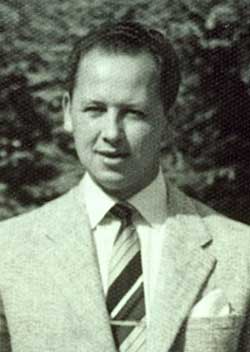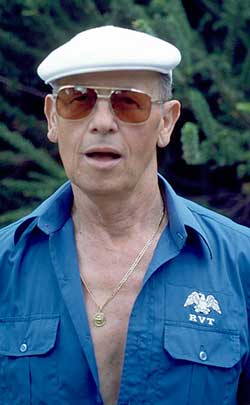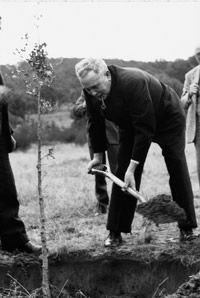History of the Gardens plumbing and irrigation
From notes written by Romeo Tomat in 1989, reproduced in 'Plumbers' News' on his retirement in 1990.
Happy retirement to Romeo Tomat -- 1990
We wish Romeo Tomat and his wife, Katherine from Montrose, Scotland, a happy, healthy and long retirement.
 |
| Romeo Tomat, 1957 |
Romeo arrived in Canberra in October 1955, aged 30, from his home in Tergestum in Italy. He recalled his father's words: 'My advice to you in your new country is to do your best and to remember that in Australia you will be an honorary ambassador for the country of your birth.' I have always remembered his words and have always done my best to live up to them.
I was able to find full board accommodation for 7 pounds ($14) a week. To go to the cinema cost 3/6 (35 cents), a packet of cigarettes 2/5, a middy of cool, golden Aussie beer 1/-, a steak dinner cost 6/- and a pair of working boots was $5. I also purchased a 1955 Holden car which cost $1200. Wages were 15 pounds a week.
Finding a job in Canberra in 1955 was not difficult. Australia was on the move and, at the suggestion of an immigration officer, I applied for a plumber's job. I started work with Parks and Gardens and, at that time, the head plumber was Stan Gent. I soon became good friends with him and many others and in only a short time I joined the Plumbers Union on 26 April 1956.
Shortly afterwards I was given the position of plumber at the Canberra Botanic Gardens. The setting of the gardens is undulating ground with gullies throughout, rising to a hillside set on the lower slopes of Black Mountain, overlooking the city. which is a few minutes away.
As soon as I saw the gardens I was very happy because it looked like typical Aussie bush. There were foxes, brown snakes, rabbits. kangaroos, possums and many different, beautiful types of birds. ln my opinion the laughing kookaburra was the king of the birds, but the magpie was one of the smartest birds because it used to come to help me eat my lunch. The gardens, to me, were a terrestrial Aussie paradise.
The actual size of the Botanic Gardens was to be 40 hectares, and at this time there were no roads or buildings. The whole area was eventually to be irrigated and controlled by a system of electrohydraulic docks. After having surveyed the land for the excavation I calculated that I needed many different sizes of galvanized pipes from 100 to 25mm. To accomplish the excavation I discovered that I needed to cut down some trees and even use dynamite to dig some of the trenches for the principal water supply.
For this.difficult job I was lucky to have the assistance of two good men, Angelo Messina and Walter Gumik. They helped me with the installation over a long period of time. As you can imagine, installing the plumbing for such a large area is no small task, especially when combined with all the follow-up maintenance required.
All the water for the gardens is pumped out of the city's main system and back up to our reservoir. The gardens are then fed by two mains, one 300mm and one 100mm. It is impossible to work out easily how many kilometres of pipe ha\'e been used to service the gardens, but an extensive network of galvanized pipes from 100 to 25mm and plastic tubes down to 6 mm connecting hydraulic valves to aquadial docks has been installed to supply a wide range of buildings, glasshouses, nursery and general irrigation. The general irrigation lines are controlled by eleven aquadial clocks strategically placed around the gardens. These clocks allow watering from 5 to 60 minutes on each of 23 stations. The irrigation sprays are laid and arranged in a staggered manner, with sprinklers 50 feet apart. 1670 Buckner sprinkler heads have been used on the general irrigation lines, mainly model nos 1330, 1294, 860, 1300, 404, 403 and 555.
One of the most challenging jobs I have had at the gardens has been to install the misting system on the Rainforest Gully. This system provides the desired moisture and humidity needed to establish rainforest plants from many parts of Australia.
 |
| Romeo Tomat, 2002 |
This misting system is controlled by two electronic clocks. It is activated by a solenoid valve. Thirteen separately controlled lines of 37 mm copper tube cover the gully. These lines contain 2200 midget misting heads, spaced about 1 m apart. The installation of this system created a lot of controversy at the time with satirical writers for the local press complaining that Canberra had enough fog without the government's making it artificially! The system has worked well, however, and now the Rainforest Gully is famous around the world.
The gardens are now called the Australian National Botanic Gardens and are a popular tourist attraction in Canberra, visited by 300,000 people each year. Most people come here because the gardens are unique. Nowhere else in the world will you find a collection of Australian native plants as large or diverse displayed in such attractive natural surroundings.
Now that this major job has been accomplished I can look back and laugh, but when I started there was often not much time for laughing.
I will retire in 1990 and feel content that I did mv best to make this a beautiful. peaceful oasis for all Australians and visitors to enjoy. One day I will pass away but my spirit will remain for ever at the gardens.
Extracted from Plumbers News March-June 1990, p.66
![Director of National Parks [logo]](../../../../images/dnp_90px.gif)






